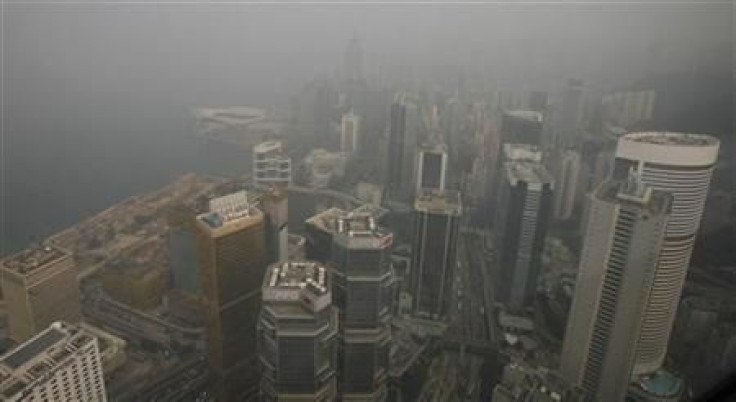Hong Kong: Heavy Air Pollution Threatens Peoples' Health And Local Economy

Pollution not only plagues China, but foul air also threatens the health and economy of neighboring island, Hong Kong, one of the world’s premier financial centers.
Hong Kong’s famous skyline is usually clogged with hazy smoke, rendering poor visibility for much of the year.
The Civic Exchange, a Hong Kong-based public policy think tank, warned that high pollution levels lead to 3,200 premature deaths annually on the bustling affluent metropolis just miles from the Chinese mainland.
Bloomberg reported that pollution in Hong Kong has been soaring since 2007.
In 2011, the crowded state recorded 175 days of “very high” pollution -- a level that triggers government warnings for people with heart and respiratory illness to avoid areas with heavy traffic --- more than double the figure from four years prior.
Last August, Hong Kong recorded its worst day of pollution in two years.
Professor Anthony Hedley, an epidemiologist at the University of Hong Kong's school of public health, told the Financial Times that there is a direct link between Hong Kong’s air pollution and the high incidence of respiratory, lung and heart diseases.
"[The bad air is] pushing people into doctors' clinics, into hospital beds and into coffins," he said.
Research from Hong Kong University indicated that as long ago as 2000 heart disease caused by pollution cost the state as much as HK$11.1 billion ($1.42 billion). On the whole, pollution is believed to be costing HK$21.2 billion ($2.7 billion) annually on lost productivity and hospital admissions.
Thousands of factories belching in Shenzhen and Guangzhou on the Mainland compound an already crisis-level problem.
"Just imagine a small power plant right next to your doorstep, producing a lot of pollution every day, almost 24 hours a day. What would you do?" Simon Ng of the Civic Exchange told AFP.
But Hong Kong’s coal-fired power stations and heavy traffic are perhaps bigger culprits in this tale of environmental degradation.
"Bad air is trapped here. But even though external circumstances can't blow away the pollutants, the problem still lies fundamentally in vehicular emissions in Hong Kong itself," Patrick Fung of Clean Air Network, a local pro-environment group, told Reuters last summer.
Indeed, among the major sources of air pollution in Hong Kong are the old, diesel-powered buses and trucks that roll across the island’s roadways, spewing smoke and exhaust.
Earlier this week, the political boss of Hong Kong, Beijing-appointed Chief Executive Leung Chun-Ying, offered a $1.3 billion subsidy to gradually eliminate these polluting vehicles.
He also suggested that newly registered diesel-powered vehicles must end their operations after 15 years of service.
"The scheme will significantly reduce the overall emissions of [harmful] particulates and nitrogen oxides by 80 percent and 30 percent, respectively," Leung said in a statement.
“We strive to improve air quality on all fronts. We must phase out old diesel commercial vehicles with greater financial incentives while putting in place more stringent regulatory measures.”
BBC reported that 40 percent of the 121,000 diesel-powered commercial vehicles in Hong Kong are considered excessive polluters (that is, they do not meet the Euro-3 emissions standards).
However, trucking and freight interests are less than thrilled with the government’s subsidy proposal.
Stanley Chaing, chairman of the Lok Ma Chau China-Hong Kong Freight Association, decried the offer as “too little,” the BBC reported.
"Most of our small business owners cannot afford to replace their diesel vehicles," he said, adding that the government should increase the subsidy so that it covers 30 percent of the cost of a new diesel-powered vehicle.
Moreover, given that marine emissions are also a serious health hazard, the Hong Kong government may also require the thousands of ships that pass by its famous harbor every year to use low-sulfur fuels.
Over 400,000 vessels crossed through the port in 2011, Agence-France Presse noted, not including the public ferries, tourist junks and luxury yachts competing for precious space on the crowded harbor and waterways.
"Ships are now producing a lot more pollutants than we had anticipated, and it is becoming a major problem that we need to address,” Ng added.
Business leaders lament that rising pollution may hurt Hong Kong’s competitiveness by driving away top talent who are seeking cleaner air and water for themselves and their families.
A survey taken last year by the American Chamber of Commerce in Hong Kong revealed that one-third of companies could not attract professionals from foreign nations due to Hong Kong’s bad air quality.
In the event that Hong Kong companies cannot attract the best talent, there are fears that they might have to relocate to other parts of the region, thereby making Hong Kong a less attractive place for foreign business to use as a springboard for the vast Chinese markets.
“It is a question of competitiveness, because people obviously make comparisons with other cities around Asia, in particular Singapore,” Christopher Hammerbeck of the British Chamber of Commerce said, according to the BBC.
On the other side of the equation, some Hong Kong residents have reportedly fled because of high pollution and its deleterious effects on their health.
Part of the problem related to spiraling pollution may have to do the government’s traditional support of business groups and laissez-faire attitude toward environmental concerns and regulations. But that may now change -- at least slightly -- given Hong Kong’s new environment undersecretary, Christine Loh, is herself a former environmental activist.
"We want to regulate,” she said at a recent air quality conference, according to AFP.
“We want it to become mandatory, and we want to take the scheme across the border to our neighbors in Guangdong [China]. We would like, within the next few years, to collaborate and work very closely with the Guangdong province so the whole of the water of the [Pearl River Delta] could be turned into a low emission zone."
© Copyright IBTimes 2024. All rights reserved.











